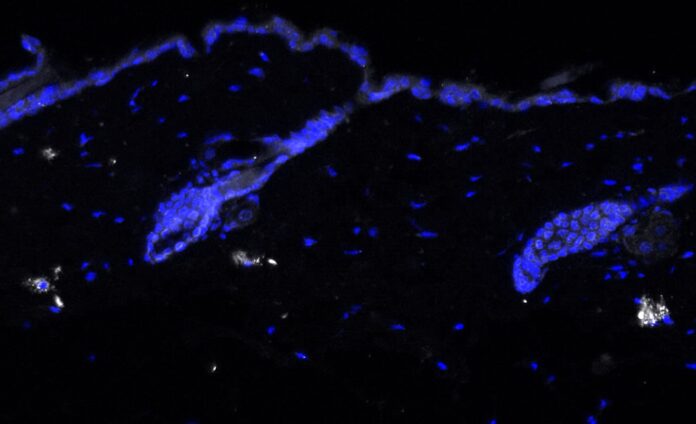Skin aging is characterized by structural and functional changes contributing to age-associated frailty. This depends on a synergistic interaction between changes to the local habitat and intrinsic stem cell changes, highlighted by proinflammatory microenvironments promoting pleiotropic changes. It is uncertain what these age-associated inflammatory stimuli are or how they influence tissue aging.
Based on single-cell RNA sequencing of the dermal compartment of mouse skin, a team of scientists from the Institute for Research in Biomedicine (IRB Barcelona), in collaboration with the National Center for Genomic Analysis (CNAG), has discovered that IL-17 protein plays a central role in skin aging.
The study highlights an IL-17-mediated aging process to an inflammatory state. It describes the alterations that occur in various cell types with aging and shows which immune cells in the skin express high quantities of IL-17.
The results show that IL-17 is involved in various functions related to aging. Scientists observed that blocking the function of this protein slows down the appearance of multiple deficiencies associated with aging skin.
Dr. Aznar Benitah, ICREA researcher and head of the Stem Cells and Cancer laboratory at IRB Barcelona, said, “This discovery opens up new possibilities for treating some of the symptoms or facilitating skin recovery after surgery, for example.”
Dr. Holger Heyn, head of the Single Cell Genomics laboratory at CNAG, said, “Single-cell sequencing has allowed us to dive deep into the complexity of cell types and states forming the skin and how these change during lifespan. We did not only find differences in the composition of aged skin but also changed in cell activity states. Particularly immune cells showed specific age-related profiles, which we could pinpoint by analyzing thousands of individual cells one at a time.”
The skin comprises a variety of epithelial cells, hair follicle cells, and other cells, in addition to immune cells, which are essential for fighting infections and defending against harm.
The study explains how several immune cells, specifically gamma delta T cells, innate lymphoid cells, and CD4+ T cells, drastically increase in number in the skin as we age. The pro-inflammatory cytokine IL-17 also begins to be expressed at high levels by these cells.
Dr. Paloma Solá, the first author of the paper, and Dr. Elisabetta Mereu said, “Ageing is associated with mild but persistent inflammation and, in the skin, this is characterized by a significant increase in IL-17, which causes skin deterioration.”
A protein called IL-17 has been linked to various autoimmune skin conditions like psoriasis, and medications already block this protein. The research team investigated how reducing IL-17 activity affected several processes, including hair follicle growth, transepidermal water loss, wound healing, and genetic markers of aging. Due to the significant delay in the onset of these aging features, these four measures showed improvement following treatment.
Dr. Guiomar Solanas, the associate researcher at IRB Barcelona, said, “What we have observed is that its temporary inhibition offers benefits that could be of interest at a therapeutic level.”
Future work by the researchers will focus on clarifying the aging processes related to inflammatory states in the skin and how these are linked to IL-17. The team will also address whether IL-17 is involved in the aging and deterioration of other tissues and organs.
Journal Reference:
- Solá, P., Mereu, E., Bonjoch, J. et al. Targeting lymphoid-derived IL-17 signaling to delay skin aging. Nat Aging (2023). DOI: 10.1038/s43587-023-00431-z
